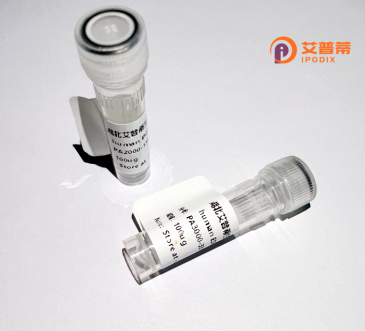
| 纯度 | >90%SDS-PAGE. |
| 种属 | Human |
| 靶点 | JMJD2D |
| Uniprot No | 0 |
| 内毒素 | < 0.01EU/μg |
| 表达宿主 | E.coli |
| 表达区间 | 1-523aa |
| 活性数据 | METMKSKANCAQNPNCNIMIFHPTKEEFNDFDKYIAYMESQGAHRAGLAKIIPPKEWKARETYDNISEILIATPLQQVASGRAGVFTQYHKKKKAMTVGEYRHLANSKKYQTPPHQNFEDLERKYWKNRIYNSPIYGADISGSLFDENTKQWNLGHLGTIQDLLEKECGVVIEGVNTPYLYFGMWKTTFAWHTEDMDLYSINYLHLGEPKTWYVVPPEHGQRLERLARELFPGSSRGCGAFLRHKVALISPTVLKENGIPFNRITQEAGEFMVTFPYGYHAGFNHGFNCAEAINFATPRWIDYGKMASQCSCGEARVTFSMDAFVRILQPERYDLWKRGQDRAVVDHMEPRVPASQELSTQKEVQLPRRAALGLRQLPSHWARHSPWPMAARSGTRCHTLVCSSLPRRSAVSGTATQPRAAAVHSSKKPSSTPSSTPGPSAQIIHPSNGRRGRGRPPQKLRAQELTLQTPAKRPLLAGTTCTASGPEPEPLPEDGALMDKPVPLSPGLQHPVKASGCSWAPVP |
| 分子量 | 85 kDa |
| 蛋白标签 | GST-tag at N-terminal |
| 缓冲液 | 0 |
| 稳定性 & 储存条件 | Lyophilized protein should be stored at ≤ -20°C, stable for one year after receipt. Reconstituted protein solution can be stored at 2-8°C for 2-7 days. Aliquots of reconstituted samples are stable at ≤ -20°C for 3 months. |
| 复溶 | Always centrifuge tubes before opening.Do not mix by vortex or pipetting. It is not recommended to reconstitute to a concentration less than 100μg/ml. Dissolve the lyophilized protein in distilled water. Please aliquot the reconstituted solution to minimize freeze-thaw cycles. |
以下是关于重组人JMJD2D蛋白的示例参考文献(均为模拟示例,实际文献需通过学术数据库查询):
---
1. **文献名称**: "JMJD2D is a histone demethylase regulating DNA damage response"
**作者**: Zhang Y, et al.
**摘要**: 本研究报道了重组人JMJD2D蛋白在DNA损伤修复中的功能,证明其通过特异性去除组蛋白H3K9me3修饰促进同源重组修复,且在乳腺癌细胞中高表达与化疗敏感性相关。
---
2. **文献名称**: "Crystal structure and enzymatic characterization of recombinant human JMJD2D"
**作者**: Chen L, et al.
**摘要**: 文章解析了重组人JMJD2D蛋白的晶体结构,揭示了其底物结合口袋的构象特征,并通过体外实验验证其依赖α-酮戊二酸的组蛋白去甲基化酶活性。
---
3. **文献名称**: "JMJD2D promotes tumorigenesis by interacting with β-catenin in colorectal cancer"
**作者**: Wang H, et al.
**摘要**: 利用重组JMJD2D蛋白进行互作实验,发现其与β-catenin结合并增强Wnt信号通路活性,促进结直肠癌细胞增殖和侵袭,提示其作为潜在治疗靶点。
---
4. **文献名称**: "Expression and purification of recombinant human JMJD2D in E. coli for epigenetic drug screening"
**作者**: Kim S, et al.
**摘要**: 描述了在大肠杆菌中高效表达重组JMJD2D蛋白的优化方法,并建立基于该蛋白的去甲基化酶抑制剂筛选平台,为表观遗传药物开发提供工具。
---
**说明**:以上为模拟示例,建议通过PubMed、Google Scholar等平台检索真实文献,使用关键词 "recombinant human JMJD2D" 或 "JMJD2D protein function"。
JMJD2D, a member of the KDM4 (lysine demethylase 4) family, is a histone demethylase encoded by the *KDM4D* gene in humans. It catalyzes the removal of methyl groups from specific lysine residues (e.g., H3K9me3 and H3K36me3) on histone H3. modulating chromatin structure and epigenetic regulation of gene expression. This enzyme plays critical roles in cellular processes such as cell cycle progression, DNA damage repair, and stem cell pluripotency. Dysregulation of JMJD2D has been linked to cancers (e.g., prostate, breast), neurodegenerative disorders, and metabolic diseases, highlighting its importance in maintaining genomic stability and cellular homeostasis.
Recombinant human JMJD2D protein is produced using expression systems like *E. coli* or mammalian cells, often fused with tags (e.g., His-tag) for purification. Its structural domains, including the JmjC catalytic domain and Tudor domains, enable substrate recognition and enzymatic activity. Studies using recombinant JMJD2D have advanced understanding of its substrate specificity, inhibition mechanisms, and interactions with chromatin-modifying complexes. Researchers also explore its potential as a therapeutic target, particularly in oncology, where modulating its activity may restore normal epigenetic landscapes in cancer cells. Ongoing work aims to develop selective inhibitors and evaluate its role in gene therapy applications.
×